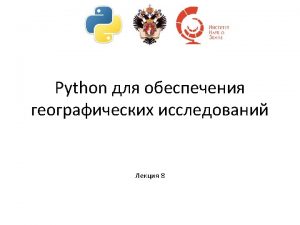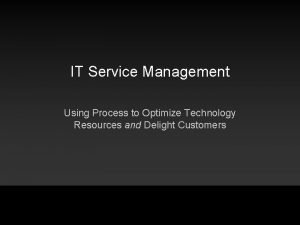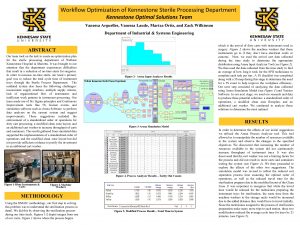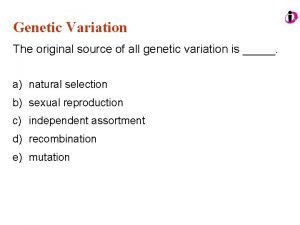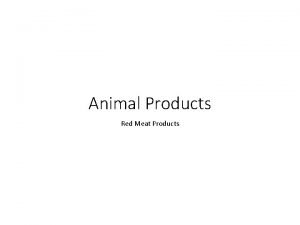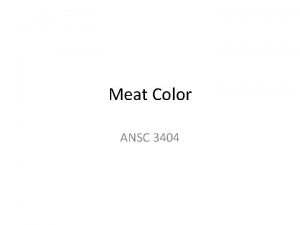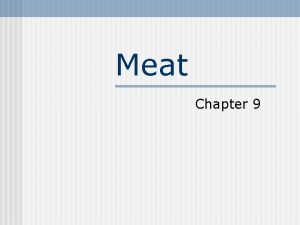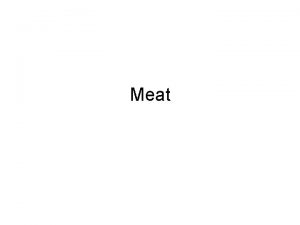Optimize Red Meat Import Process from Australia through








































- Slides: 40

Optimize Red Meat Import Process from Australia through Barcodes

Presenters Des Bowler Management for Technology Liz Sertl GS 1 US Clarissa Moreaux NAMI Len Lang Meat Import Council of America

Introduction • The purpose of this presentation is to provide import houses and further manufacturers who receive imported red meat products from Australia, the information needed to optimize and increase transparency in the import process through the use of GS 1 barcodes. • The information in this presentation will provide details on how to reduce specific shipping mark rejections through the use of FSIS Directive 9900. 5 and assess the use of barcodes as in lieu of shipping marks as detailed in FSIS Notice 37 -19.

Contents • • Supply Chain Overview GS 1 US Standards for Meat Traceability Meat Messaging System (Australia) Import House Shipping Mark Remarking - FSIS Directive 9900. 5 Barcodes in Lieu of Shipping Marks Pilot Program - FSIS Notice 37 -19 Applying GS 1 Standards Benefits to GS 1 Barcodes and Additional Resources

Supply Chain Overview

FARM EXPORT PROCESSING LIVESTOCK SLAUGHTER/CHILLING BONING DISTRIBUTION Unique IDs for farms and each head of livestock, government regulated production and husbandry systems, accurate record keeping along with third-party audits ensures your meat quality is guaranteed right from source. Each animal is inspected before and after slaughter and every carcase is identified. All carcases can be traced. Company and Australian government monitoring systems inspect plant hygiene, offal, carcase and residues. Before being placed in cartons, the meat goes through hygiene testing as well as product specification inspections. Each carton is then barcoded to identify contents and track journey. This dispatch process is authenticated by the Australian government through the issuance of export certificates as well as container sealing. Temperature is monitored at all times till the meat leaves the supermarket shelves. AUSTRALIAN GOVT. NVD NLIS GS 1 BARCODE SYSTEM AUSTRALIAN GOVT. Plant Hygiene Testing MEAT MESSAGING AUSTRALIAN GOVT. 100% GUARANTEED HALAL MEAT GS 1 BARCODE AUSTRALIAN MESSAGING SYSTEM GOVT. Product Specification Inspection Preparation for export Inspection before Slaughter Carcase Hygiene Testing Carton-Product Hygiene Testing Temperature Monitoring

IMPORT DISTRIBUTION MEAT MESSAGING GS 1 BARCODE SYSTEM USDA INSPECTION This dispatch process is authenticated by the Australian government through the issuance of export certificates as well as container sealing. The US government confirms the authenticity and safety of goods. Temperature is monitored at all times throughout the supply chain. DISPATCH CONTAINER The container is not reopened until it reaches its port of destination. Cartons of meat are unloaded from refrigerated containers which are then inspected by the US government. E AUSTRALIAN GOVT TO U. S. GOVT CONTAINER OPENING Australian e Cert for meat products to US Customs and USDA. Cartons re inspected by USDA utilizing GS 1 barcoding for verification through Meat Messaging Notice 37 19. Temperature Monitoring Import Re-inspection Distribution Channels

GS 1 Standards for Meat Traceability 8

GS 1 Standards 9

Where It All Starts 10

Identify: GS 1 Identification Numbers GS 1 Standards begin with GS 1 Identification Numbers used to uniquely distinguish all products (trade items), logistics units, locations, assets, and relationships across the supply chain from manufacturer to consumer. 11

Capture: GS 1 Data Carriers are capable of holding varying amounts of data to accommodate different needs such as Batch/Lot information and expiration dates. 12

Why are SSCCs Used – the Challenge Receiving • What is on this trailer? How can I improve the efficiency of the receiving process at distribution centers and stores? Tracking • What’s in a given logistics unit? Where is that logistics unit? Where is the product I’m looking for? If something is missing, what is it? 13

ASN + SSCC + Label Working Together Advance Ship Notice GS 1 Logistics Label SSCC encoded into a GS 1 -128 Barcode 14

GS 1 -128 Barcode Foundation for Visibility • When using a GS 1 -128 barcode, Application Identifiers (AI’s) are encoded for scanning purposes. AI’s are flags that precede each piece of data in a barcode to identify its meaning and format. • GS 1 -128 provides the ability to string together additional fields of information: − (01) precedes a GTIN ( 00614141987658 ) − (11) precedes Production Date (YYMMDD) (0715) − (21) precedes Serial Number ( ABC 123 ) 15

Application Identifiers (AI’s) • When using GS 1 -128 barcodes for food items in the supply chain, it is recommended that the following information should be encoded in the barcode: 1. Item Identifier = Global Trade Item Number (GTIN) 2. Date = Production, Packaging, Expiration, Sell By or Best Before 3. Production Information = Serial Number Application Identifier Listing 16

Share: GS 1 Data Exchange 17

Meat Messaging System (Australia)

Meat Messaging System – What is it? Meat Messaging is an industry cloud portal operated by the Australian Meat Industry to hold export consignment and case level information. Meat Messaging is used by: Australian Exporters To upload consignment information (through a EDI 856 GS 1 ASN) including the GS 1 barcode and production details on each case in a consignment. Inspection Houses To verify specific cases belong to a consignment when the shipping mark is missing or eligible (USDA FSIS Directive 9900. 5) or as part of the Pallet Pilot (FSIS Notice 37 -19 Pilot Program. ) End Users (value adding or further processing) To access information on individual cases such as Chemical Lean value, production data


Using Meat Messaging System (Import Houses & End Users) Step 1: Logging into the Meat Messaging web site and using ‘Search’. Step 2: Using the Meat Messaging App (Android/i. Phone) scan a pallet using a Socket Bluetooth barcode scanner. Step 3: Using the App ‘Search’ function to find the consignment ‘All Carton Serial Number Report’ To use Meat Messaging an inspection house or End User must be registered with Meat Messaging

Meat Messaging System – When to use it? Import Houses At time of inspection if a case is missing a shipping mark, Meat Messaging can be used to verify the case belong to the consignment. Refer to USDA FSIS Directive 9900. 5 Rev 1 for details. End Users End users (value adding or further processing) can use Meat Messaging to find detailed information on a consignment or case. Refer to USDA FSIS Directive 9900. 5 Rev 1 for details.

Import House Shipping Mark Remarking FSIS Directive 9900. 5

FSIS Import Inspection – Label Verification FSIS Import Label Verification • Requires the shipping mark or identification mark on the product units listed in the Foreign Inspection Certificate among other details (9 CFR 327. 4 (e)). Example (Individual product unit that would be inspected at import) • Labels are verified in accordance with FSIS Directive 9900. 5 Label Verification of Imported Meat, Poultry, and Egg Products • If product has missing, incorrect, or illegible shipping marks FSIS will refuse the Label Verification Type of Inspection (TOI) in PHIS, an automatic refuse entry for the entire lot is triggered. U. S. Approval stamped on every case for approved lots Australian Shipping mark

FSIS Import Inspection – Label Verification • When a lot is refused by a failed Label Verification TOI, the applicant may appeal (9 CFR 327. 24) or request to correct the labeling noncompliance in writing to the Front Line Supervisor (FLS). Importers or the applicant have the opportunity to correct the issue by: Discard non-compliant Containers ØSorting out the noncompliant containers Partial Illegible Mark ØImport establishment may re-apply or correct the mark without supervision of foreign government Completely Illegible Mark • Importer may correct by re-labeling under the supervision of the foreign government (costly and time consuming)

Official Import Facility Remarking FSIS Directive 9900. 5, Section VII, E. Procedures for Correcting Shipping Marks when Using Barcodes Import Establishment can correct shipping marks without having a representative of the foreign government to supervise ØOnly when FSIS can verify the unique identifier within a barcode on the shipping unit using supporting documentation from the foreign country. Supporting Documentation is available for Australian products through Meat Messaging ØMeat Messaging System can be accessed by import establishment to view barcodes linked to the certificate ØSame Day at no Cost Only allowed for countries that are eligible & only applies to establishments approved for such activity. ØAustralia is eligible & FSIS inspection personnel maintain a list of approved Australian establishments in the FSIS internal Share. Point site they access to verify eligibility.

Barcodes in Lieu of Shipping Marks Pilot Program FSIS Notice 37 -19

FSIS Notice 37 -19 Barcodes in Lieu of Shipping Marks Pilot Program for Fresh Meat Products from Australia • Notice 37 -19 is a study to assess the use of barcodes in lieu of shipping marks and not to be confused with the barcode procedures used for correcting shipping marks found in FSIS Directive 9900. 5. • Shipments in this pilot will move intact to official establishments in the U. S. for further processing.

FSIS Notice 37 -19 Barcodes in Lieu of Shipping Marks Pilot Program for Fresh Meat Products from Australia Shipping Mark ØInstead of Australia applying their shipping mark on products shipped to U. S. the barcodes on the pallet placard and individual cases will be used to verify approved Australian product in lieu of the shipping mark USDA Official Import Mark ØInstead of applying the USDA official import mark of inspection to the individual cases, the mark is applied only to the barcode placard on each pallet in the shipment Pallet Wrapping ØInspection personnel will perform label verification without removing the plastic wrapped around the pallet, as long as the label attributes are visually identifiable.

FSIS Notice 37 -19 (continued) Australia certifies export shipments through electronic certification (e. CERT) to U. S. ’s Public Health Information System (PHIS) The shipping mark data field in PHIS (i. e. , the shipping mark on the certificate) will correspond to the last nine digits of the Message SSCC on the pallet placard. SSCC is Serial Shipping Container Code. IPP are to verify that the last nine digits of the Message SSCC on each pallet placard match the shipping mark data in PHIS when performing Assessment The Message SSCC identifies the shipment and the Pallet SSCC identifies the individual pallet. The Pallet SSCC is linked to the individual case barcodes within the pallet. Individual unit barcodes are in GS 1 -128 format. 1. 2. 3. 4. 5. 6. 7. 9. 10. Pallet SSCC (i. e. , specific to the individual pallet); Message SSCC (i. e. , the unique identifier for the shipment); Producing foreign establishment number; Place for the U. S. import mark of inspection; Production dates; Net weight; Number of units on the pallet; Handling instructions; and Exporting establishment name and address.

Meat Messaging System Barcode Report • The Message SSCC is recorded under the SSCC (upper left corner) and Message File Name on the All Carton Serial Number Report below. This is the unique identifier code for the shipment that represents all product certified at the conveyance level Pallet 1 SSCC Individual Case Barcodes (GS 1128) within the pallet Pallet 2 SSCC Individual Case Barcodes (GS 1 -128) within the pallet

Applying GS 1 Standards

Applying GS 1 Standards • Visual representation on the next slide • GS 1 layer – Foundational infrastructure recommended to achieve supply chain traceability using GS 1 -128 barcodes implemented by the supplier, distributor, import house, further manufacturer (Industry, non-regulatory bodies) • Regulatory Layer – Regulatory electronic data systems utilized and traceability details regulatory entities focus on or require within the scope of identifying establishments, products, and required details on the pallet placard at import (specific to Notice 37 -19) • Import House Layer – Example of how industry can implement case level traceability using GS 1 standards while still maintaining necessary information required by regulatory bodies.

Applying GS 1 Standards

Applying GS 1 Standards

Applying GS 1 Standards

Benefits to GS 1 Barcodes & Additional Resources

Benefits to GS 1 Barcodes • If the pilot is successful the goal for expansion would be to use barcodes in lieu of shipping marks for carcasses, boxes of primal/sub-primal cuts, and processed products. • Benefits to using GS 1 barcodes to track and connect products to lots produced are increased transparency in supply chain. Increased transparency can allow for: – Quick response to issues – Quick traceback (no more paper shuffling) – Reduce time and cost for shipping mark remarking – Reduce issues associated with shipping marks • Additional Benefits to using Meat Messaging System – Certificate information 30 days in advance of product arrival – Fat- Lean percentage per box – Certificate of Analysis

Additional Resources Meat Messaging • To register with Meat Messaging go to: https: //www. meatmessaging. info/register. asp • For more information on using the Meat Messaging search function for consignments or cases go to: https: //www. meatmessaging. info/docs/Quick_instructions_for_searching_20191101. pdf • For workflow details on the Pallet Pilot go to: https: //www. meatmessaging. info/palletising. asp • Meat Messaging industry portal is based on the GS 1 standards for identification of consignments and barcodes on cases. For detail on case barcodes as supplied by Australian exporters go to: https: //www. meatmessaging. info/docs/3_Carton_Technical. Fact. Sheetfinal. pdf GS 1 Resources • North American Industry Guidance for Standard Case Code Labeling (link) • GS 1 Barcode Chart (link) • Meat and Poultry Implementation Guide (link) • Starters Guide to Using Barcodes (link) • Foodservice Manufacturer Implementation Checklist (link) • GS 1 Implementation Guide for Grocery Retailers (link) • GS 1 Implementation Guide for Foodservice (link) • GS 1 Barcode Guidelines for Cases/Cartons in Foodservice (link) • Find a GS 1 US Solution Partner (link) FSIS Directives and Notices • Title 9 CFR 327. 4 • FSIS Directive 9900. 5 Label Verification of Imported Meat, Poultry, and Egg Products • FSIS Notice 37 -19 Barcodes in Lieu of Shipping Marks Pilot Program For Fresh Meat Products From Australia

Additional Questions? Join the pilot U. S. Company email Rob Williams: rswilliams@mla. com. au Join the pilot Foreign Company email Laurie Bryant: lauriebryant@micausa. org GS 1 Standards email Liz Sertl: ESertl@gs 1 us. org Meat Messaging email Des Bowler: desbowler@initmedia. com. au Other questions email Clarissa Moreaux: cmoreaux@meatinstute. org
 Import java.awt
Import java.awt Java import java.util.*
Java import java.util.* Import numpy as np import matplotlib.pyplot as plt
Import numpy as np import matplotlib.pyplot as plt Import java.awt.event.*;
Import java.awt.event.*; Optimize wastewater lagoon
Optimize wastewater lagoon Loyalty spaarsysteem
Loyalty spaarsysteem Itil smo
Itil smo Optimize sterile supply workflow
Optimize sterile supply workflow Sql sucks
Sql sucks Disk usage by top tables
Disk usage by top tables Np import
Np import Innovia consulting
Innovia consulting Optimise plant availability
Optimise plant availability Which market forms of meat is best
Which market forms of meat is best Red meat vitamin
Red meat vitamin By one man sin
By one man sin Through and through furcation
Through and through furcation Conversion in timber
Conversion in timber Night of the scorpion written by nissim ezekiel
Night of the scorpion written by nissim ezekiel What is a simile in stereo hearts
What is a simile in stereo hearts Alsf ii approach lighting system
Alsf ii approach lighting system A red, red rose figures of speech
A red, red rose figures of speech Love is like a rose
Love is like a rose Red gri
Red gri White over red pilot ahead
White over red pilot ahead Poetic devices table
Poetic devices table Why does a red ball look red?
Why does a red ball look red? Purple
Purple Red orange yellow green blue pink
Red orange yellow green blue pink Red short horned cattle are homozygous for the red allele
Red short horned cattle are homozygous for the red allele The process of acquiring through experience new
The process of acquiring through experience new Self-socialization
Self-socialization Socialization is a lifelong process discuss
Socialization is a lifelong process discuss The process of change over time is
The process of change over time is Talenttransformation.wipro com
Talenttransformation.wipro com The process of seeing ourselves through the eyes of others
The process of seeing ourselves through the eyes of others Green hat questions
Green hat questions Slidetodoc.com
Slidetodoc.com From turtle import * python
From turtle import * python Import substitution industrialization
Import substitution industrialization Import tkinter as tk
Import tkinter as tk


